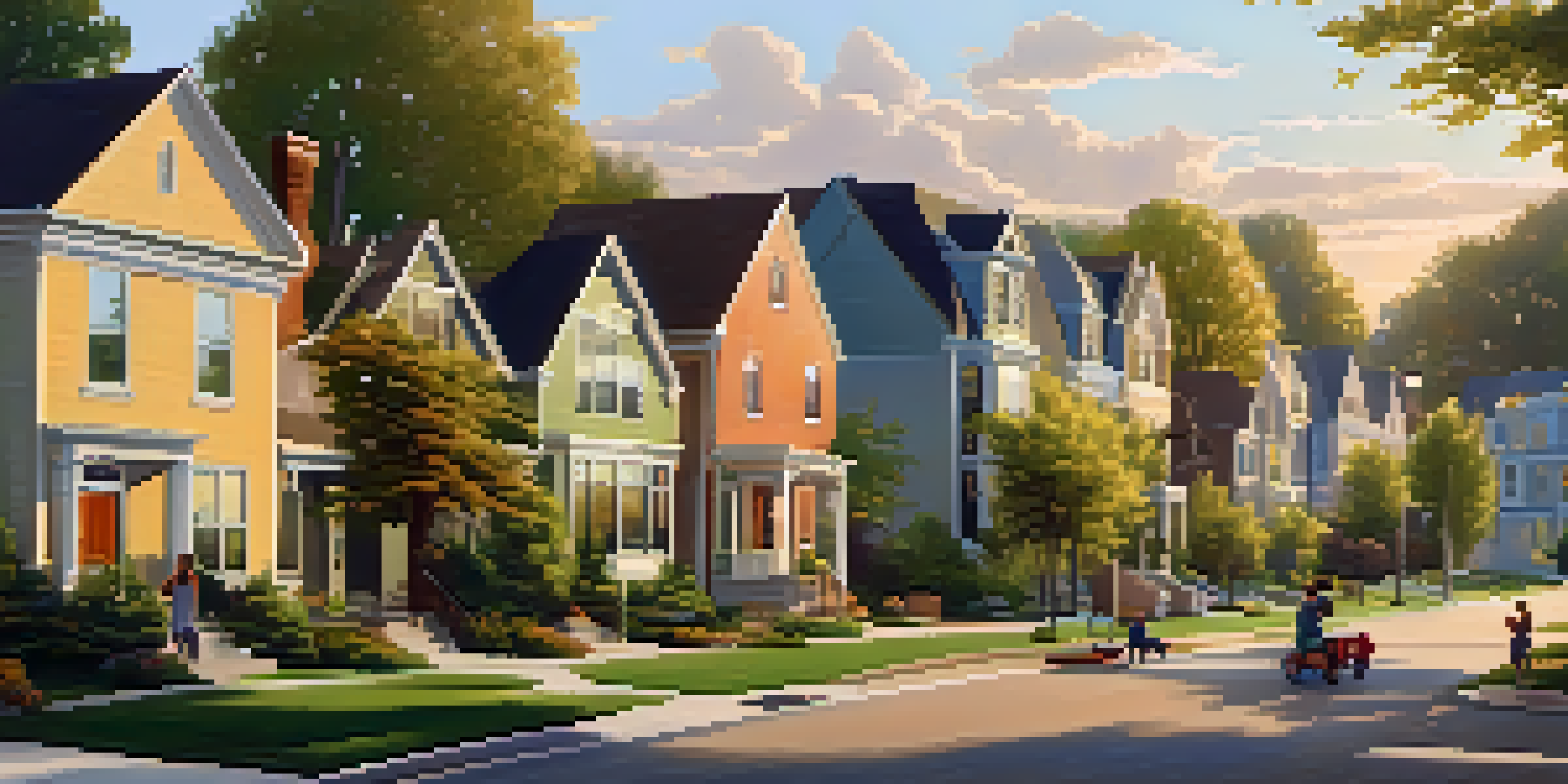The Influence of Local Culture on Real Estate Preferences

Understanding the Role of Local Culture in Real Estate
Local culture plays a pivotal role in shaping real estate preferences. It encompasses the traditions, values, and lifestyle of a community, which can influence what types of homes people desire. For instance, a community that values open spaces may prefer homes with large yards, while urban areas may lean towards high-rise apartments.
Architecture is the thoughtful making of space.
Cultural influences also dictate architectural styles and neighborhood layouts. In a region with a rich history, you might find a preference for historic homes, while modern developments may dominate areas focused on innovation. This diversity in preferences underscores how deeply local culture affects housing choices.
Moreover, the significance of local culture can vary greatly from one area to another. For example, coastal communities might prioritize beachfront properties that allow for outdoor activities, while mountainous regions may see a rise in demand for cabins or chalets. Understanding these nuances aids real estate professionals in catering to clients' needs.
Cultural Heritage and Architectural Preferences
Cultural heritage significantly influences architectural preferences in various regions. Traditional designs often reflect the history and customs of a locality, making them appealing to residents who value their roots. For instance, adobe-style homes are prevalent in Southwestern U.S. areas, showcasing the cultural heritage of Native American and Spanish influences.

In contrast, urban areas might feature a blend of modern architecture with historical elements. This fusion caters to a demographic that appreciates both contemporary living and historical context. Buyers in such areas often seek properties that embody this unique architectural dialogue.
Local Culture Shapes Housing Choices
Local culture influences the types of homes, architectural styles, and neighborhood amenities that communities prefer.
Understanding these architectural trends can guide real estate developers in creating properties that resonate with local culture. By incorporating traditional elements into new builds, they can attract buyers who cherish their cultural identity while still desiring modern conveniences.
Local Values and Neighborhood Amenities
Local culture shapes the amenities that communities value most. For example, neighborhoods with a strong emphasis on family might prioritize parks, schools, and community centers. This focus creates a demand for homes in areas that offer these facilities, as families often seek environments conducive to raising children.
Culture is the widening of the mind and of the spirit.
Conversely, areas with a vibrant nightlife or artistic community may prioritize proximity to restaurants, galleries, and entertainment venues. Buyers in these regions might be more inclined to choose properties close to cultural hotspots, reflecting their lifestyle choices. Thus, the local culture directly influences the types of amenities that become attractive.
Real estate agents who understand these values can better serve their clients by highlighting properties that align with local interests and amenities. This alignment not only enhances client satisfaction but also fosters a sense of belonging within the community.
Socioeconomic Factors Influenced by Local Culture
Socioeconomic factors, often intertwined with local culture, can also impact real estate preferences. Communities with higher income levels may lean towards luxury properties, while lower-income areas may prioritize affordability. Understanding these dynamics is crucial for real estate professionals when targeting specific markets.
Moreover, cultural attitudes towards homeownership can vary based on socioeconomic status. In some cultures, owning a home is seen as a significant milestone, while in others, renting may be more common. These attitudes not only affect buyer behavior but also influence developers' investment strategies.
Community Engagement Drives Trends
Active resident involvement in local decisions can lead to the demand for properties that align with community values and desires.
By recognizing these socioeconomic trends, real estate agents can tailor their services accordingly, ensuring they cater to the specific needs and preferences of diverse communities. This approach not only enhances their market reach but also fosters trust and loyalty among clients.
Community Engagement and Real Estate Trends
Community engagement plays a crucial role in shaping real estate trends. When residents are actively involved in local decisions, their preferences often reflect their desires for the neighborhood's future. This influence can lead to a rise in certain types of properties, such as mixed-use developments that promote community interaction.
For instance, neighborhoods that prioritize sustainability may see a demand for eco-friendly homes and community gardens. These trends not only cater to the local culture but also attract like-minded buyers who value environmental responsibility. Real estate professionals must stay attuned to these shifts to remain relevant in the market.
By fostering community engagement, developers can create spaces that resonate with residents, ultimately leading to a more successful real estate venture. This collaborative approach ensures that new developments align with local values and contribute positively to the community.
The Impact of Local Events on Housing Demand
Local events, such as festivals or cultural gatherings, can significantly impact housing demand. These events create buzz and excitement around certain neighborhoods, leading to increased interest in nearby properties. For example, a popular music festival might draw attention to an area, prompting potential buyers to consider its housing options.
Moreover, the frequency and nature of local events can influence long-term real estate trends. Areas that consistently host cultural or sporting events may become more desirable, as residents seek to be part of the vibrant community. This can lead to rising property values and competition among buyers.
Cultural Diversity Enriches Real Estate
Cultural diversity within a community enhances the variety of housing styles and amenities, attracting a broader range of buyers.
Real estate agents can capitalize on these trends by monitoring local events and their effects on housing demand. By staying informed, they can better advise clients looking to buy or sell in areas experiencing heightened interest due to cultural happenings.
Cultural Diversity and Its Effect on Housing Choices
Cultural diversity within a community can greatly enrich the real estate landscape. A melting pot of cultures often leads to a variety of housing styles and preferences, creating a dynamic environment for buyers. For instance, neighborhoods with significant immigrant populations may see a demand for multi-generational homes that cater to extended families.
Additionally, cultural diversity can influence the types of businesses and amenities that flourish in an area. From international restaurants to specialty shops, these establishments can enhance the appeal of a neighborhood, attracting buyers who appreciate diverse offerings. Such factors can lead to increased interest in local real estate.

Real estate professionals must recognize the importance of cultural diversity in shaping housing choices. By understanding the unique needs and preferences of various cultural groups, they can better serve their clients and promote properties that resonate with a broader audience.